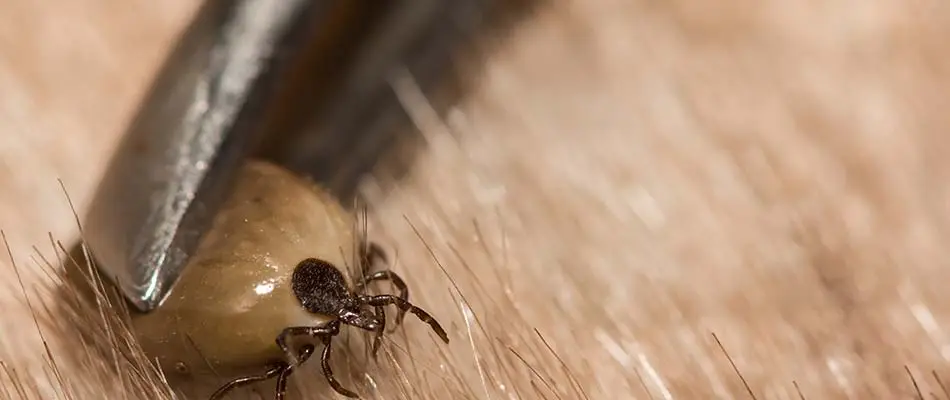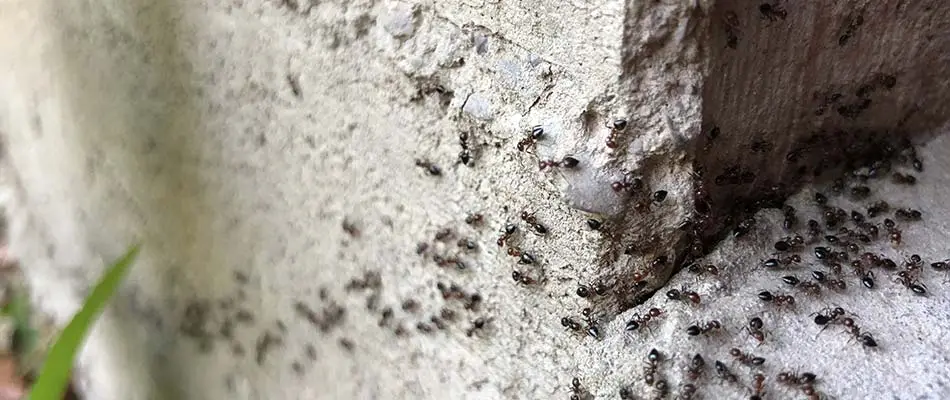Home Defender Package
It’s probably happened to you before: you’re lying in bed or sitting in a chair, and you feel something crawl across you. Maybe you leap up and shake it off. Maybe you lie still hoping that whatever it is gets off you, and fast. Regardless, you don’t appreciate being in a real-life version of that famous James Bond scene when he awakes to a tarantula crawling across him in the middle of the night.
Insects and other multi-legged pests inside the home are not just creepy and unwanted. They can be harmful to people and pets, and they can cause structural damage. There are ways to prevent them from getting in that you can do yourself, but the best way is perimeter pest control performed by a professional company. This treatment creates a barrier outside the home to prevent entry by these pests.
How Do They Get In?
You may think you do a reasonably good job keeping bugs out by keeping doors and windows shut and making sure there aren’t holes in screens, but you’re still finding them. What’s going on?
Sometimes, you may be bringing them in yourself. Insects and other small critters love to hitch rides, and people often bring them in from outside. Pets can bring them in as well.
There may also be entry points of which you are unaware. Small cracks and other openings around the foundation, and doors and windows not sealed properly, provide some ways for pests to get inside.
In addition, conditions outside the home but close to its perimeters may be attracting pests. Areas where you store trash bins, damp areas, and even gardening features that can be attractive to pests all are examples of this. When the pests show up and there are ways to get inside, they’re going to get inside.
Weather is also a big factor. The extreme times of year (summer and winter) can drive pests to seek shelter indoors.
Common Household Pests and the Harm They Cause

Unwanted pests can transmit diseases, and their bites and stings can cause unpleasant reactions, including allergic ones. In addition, pests that are not typically harmful to full-grown adults can be dangerous to smaller targets such as pets and children.
- Ticks are well-known carriers of Lyme disease, a common affliction that can take a long time to cure.
- Chigger bites cause itchiness and can take three weeks to heal, and scratching the bites can lead to infection.
- Mosquitoes are mostly an outside problem, but they excel at getting inside, where they are annoying and where their bites cause itchy reactions and can transmit diseases such as West Nile virus and Zika virus to people. They also can pass on a parasite that causes heartworm in dogs and cats.
- Cockroaches are among the worst and something no one ever wants to see inside, and for good reason: cockroaches can trigger allergic reactions and asthma symptoms, with children at higher risk, and they carry pathogens known to spread E. coli, salmonella, and parasitic worms.
- Termites are a major threat to a home. Not all threats are to health, and a termite infestation can be devastating because of the structural damage they can do to a home. Termites like to eat cellulose, a fiber abundant in wood. Every year, termites cause over $5 billion in damage to American homes alone, and an infestation can mean thousands of dollars in damage for an individual household.
- Bed Bugs, like ticks, feed on the blood of their hosts. Because they spread quickly, they can be very difficult to control. Rarely, bites cause serious allergic reactions.
- Fleas have itchy bites. We mostly think of them as targeting hairy pets, but they bite people, too. They can also transmit typhus and tapeworms.
- Biting flies can pass on a parasite causing onchocerciasis, which can produce itchy rashes and can lead to permanent skin damage and vision loss.
- Spider bites are rare and usually inconsequential, but there are exceptions, most notably black widow and brown recluse spiders, the two species in America considered very dangerous. However, bites from other spiders make some people very sick and sometimes require hospital visits. Again, children are more at risk. So are people with compromised immune systems.
- Ants are attracted to odors from food. Once an infestation occurs, they can be hard to remove. Spraying them with insecticide works on the visible ants, but there are often many more out of sight, and so the source remains untreated.
- Bees and wasps deliver painful stings, and some people are deathly allergic to them
Perimeter pest control like that Sharp Lawn Care provides will get rid of and keep out these pests.
What You Can Do
- To repeat the obvious, make sure outside doors stay shut and that screens on doors and windows don’t have holes and are attached securely. If just one little spot in the corner is loose, you can bet bugs will find their way in.
- Check the caulking around doors and windows and reinforce it as necessary
- Keeping a clean household is important, too. Food odors and sticky messes have a way of attracting pests, especially ants.
- Do your laundry regularly. If you or others are giving pests an unplanned ride in, doing the laundry regularly instead of letting it pile up can help stop pests from spreading.
- Use sticky traps. This will not really control the pests, but if you are regularly catching them, this could be a sign that there is a problem requiring professional attention.
- When pests are present, you may want to use a pesticide. If you do this, be extremely cautious and read all labels carefully, as these products can be very dangerous to humans and pets.
- Outside, store trash bins and firewood away from the house and trim plants growing against the house.
- Wash pets regularly. Some of them hate that, but it’s good for them, and you!
Perimeter Pest Control
Prevention is great, but it will not be 100% effective. There are just too many pests out there, and they are too persistent. This is why we recommend and provide perimeter pest control.
After one of our specialists inspects your property to determine what needs to be done and locates trouble spots elsewhere, not just along the perimeter of the house, we will treat the perimeter of your home with our eco-friendly formula that is lethal to pests but does not harm the environment.
We don’t just treat the perimeter. Because we know there are all kinds of ways pests get in, we also give special attention to other areas where pests are likely to enter or to congregate such as cracks, crevices, and other openings in the foundation. We’ll also look at mulch beds, decks, doors, windows and window wells, crawl spaces, and places you store trash bins.
In effect, perimeter pest control creates an invisible barrier around your home. No chemicals ever go inside your home.
March through November, we will return monthly to re-treat the perimeter to maintain the barrier.
Our treatment creating a barrier outside your home does more than just get rid of pests you’d rather not see and deal with. It keeps your home and your family safe and protected for as long as you live there. For a free quote, contact us today!
We’ve linked tools and products in this article that may help you complete this work yourself. As an Amazon Associate, we earn from qualifying purchases.




Comments (0)
Thanks for your comment!
Thanks for your feedback! Your comments have been successfully submitted! Please note, all comments require admin approval prior to display.
Error submitting comment!
There is a problem with your comment, please see below and try again.